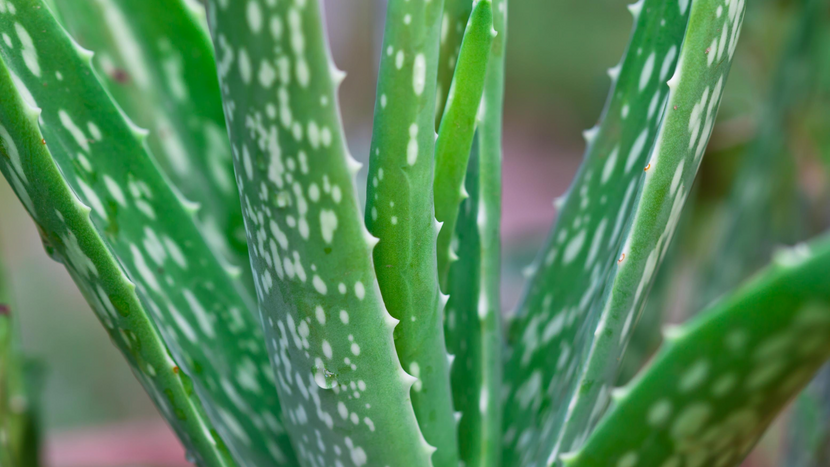How to Care For Aloe Vera Plants
Plant Guide

Aloe vera is commonly found in lotions, suncare, medicine, you name it. But Aloe vera is also an easy to maintain and adorable plant! Due to its susceptible nature to colder temperatures, the Aloe vera plant is most commonly used as a houseplant. Generally, a mature Aloe vera plant can bloom bright orange flowers, however, as a houseplant, this is a very difficult task.
Here are a few tips on how to care for your Aloe vera plant:
Ground Rules
Light
Aloe vera plants require full sun; six to eight hours is recommended. When transferring your plant outside, do not immediately put it into direct sunlight, or it could sunburn. In the same way, it can tolerate some shade or filtered light in the middle of the day, when the sun is the strongest.
Water
Generally, you want to water your plants when the top inch of the soil is dry to the touch. Do not let the soil of your aloe plant to completely dry out. An indication that your plant is parched is when it develops brown tips at the ends of its leaves. Overwatering is just as bad; signs of this are black spots on the leaves and root rot.
We recommend giving your Aloe vera plant a slow, deep watering about every 3 weeks, less during winter dormancy.
Most plants require drainage holes to prevent root rot. If you opt for a decorative planter with no drainage, we recommend adding pebbles to the bottom of the pot and then nestling a smaller terracotta pot on top of the pebbles within the decorative planter.
Soil
Organic Potting Mix works well for most indoor plants. For optimal results, a soil mix with a 2:2:1 ratio of all-purpose potting soil, coarse sand, and pumice or perlite. This mixture will drain well as the aloe plant requires.
Food
Adding a small amount of fertilizer to your potted aloe will help replenish the plant with nutrients it has lost over time. Plant food such as Jack’s Classic All Purpose Fertilizer, or a succulent fertilizer can be added to your watering schedule to ensure healthy roots and leaves. After repotting, don’t add fertilizer until your plant starts showing signs of new growth.
If planted in the garden, one application in the spring should suffice for the whole year.
Temperature
When planted outdoors, Aloe vera plants can tolerate hardiness zones 10-11. That is why they are commonly used as house plants, where they can be in their comfort level of 60 to 80 degrees Fahrenheit. If you would like, you can move your Aloe vera outside during the spring and summer, then bring it in for the winter months. When moving your aloe outside, be sure not to place it in direct sunlight.
Toxicity
Although the gel inside the aloe plant has healing properties, it is meant for external use and should generally not be ingested. The toxic properties lie within the small layer of latex between the skin and the gel. This misuse of latex can lead to stomach cramps, muscle weakness, and kidney problems when consumed long term.
Planting Process
- Gather all your tools and clean your shears with rubbing alcohol to keep your plant disease-free and healthy.
- Turn your aloe plant sideways and carefully slide it out of the container it came in while keeping the root ball intact. A gentle tap can do the trick if your plant is stubbornly clinging.
- Loosen the soil around the roots and trim any roots that are discolored, rotten, or too long.
- Place a coffee filter, large stone, pebbles, or screen on the bottom of your planter so that the soil or roots don’t clog the drainage hole. Then put a layer of fresh soil on the bottom of your pot.
- Put your plant in the center of your pot, filling the pot with fresh soil. Leave 1 inch of space from the top of the soil to the top of the pot so it does not overflow when watering.Over time, your plant will overgrow its pot and the roots will push the plant upward. You can tell if a plant needs to be repotted if the 1” of space at the top has gotten smaller over time.
- Water your plant thoroughly in a sink or outside so it can get a good soaking but also drain adequately.
When you receive your Aloe vera from Garden Goods Direct, it is possible it has gone through a bit of shock during shipment from being in a dark box. This is perfectly natural. If given proper care, your indoor plants will thrive and grow to surprising new heights. If you put it immediately into direct sunlight, you run the risk of giving it sunburn.
Your new plant needs time to acclimate to its new surroundings, so give it some water and place in indirect sunlight.

